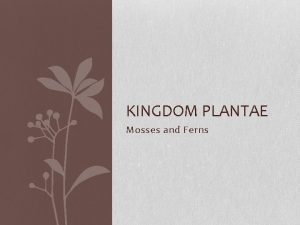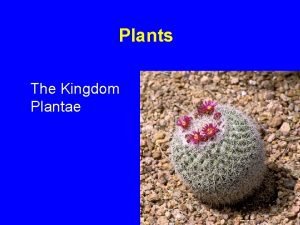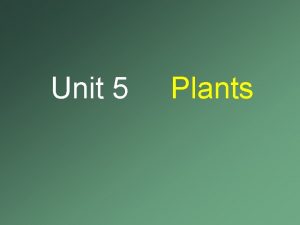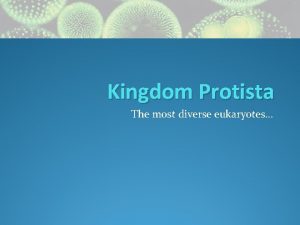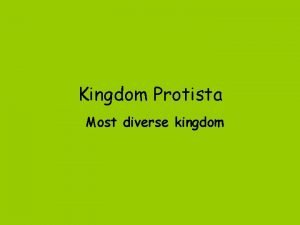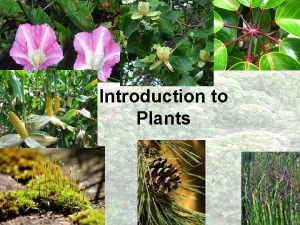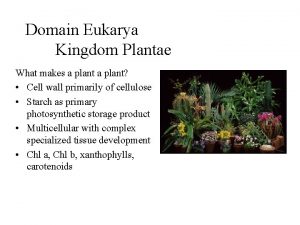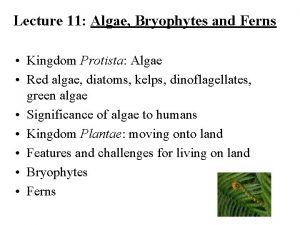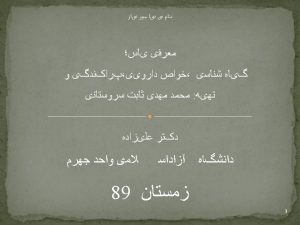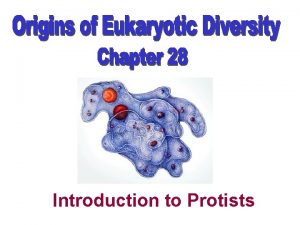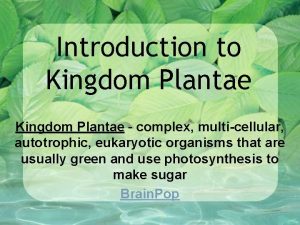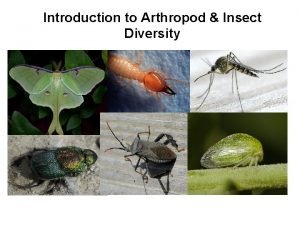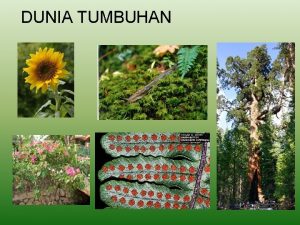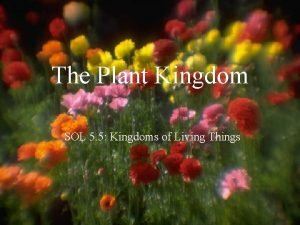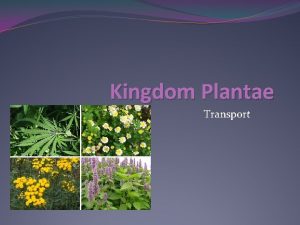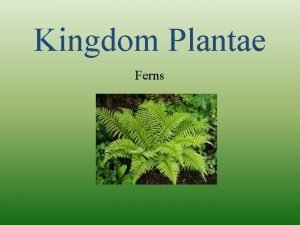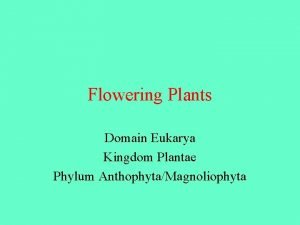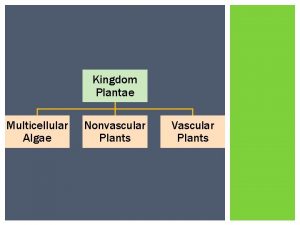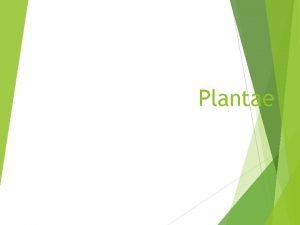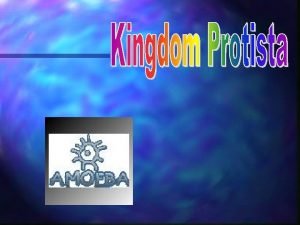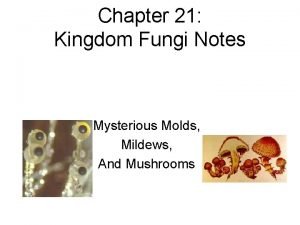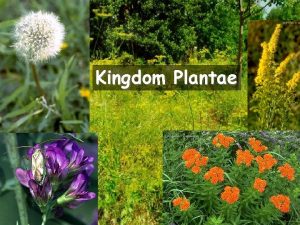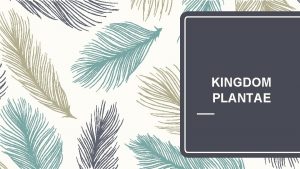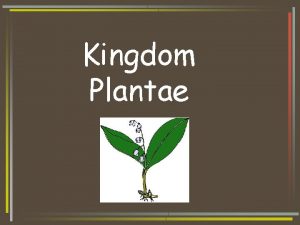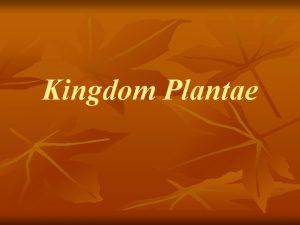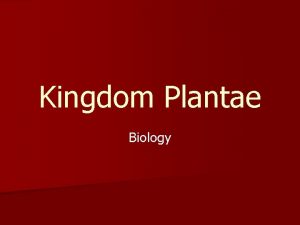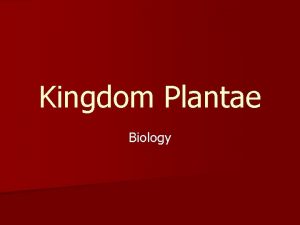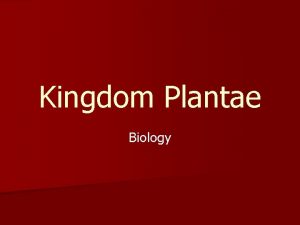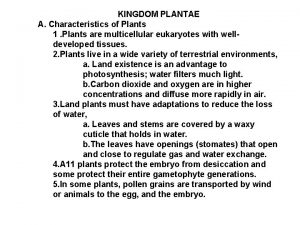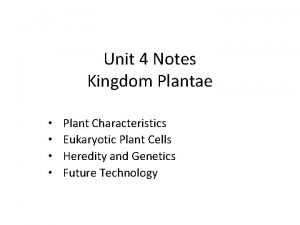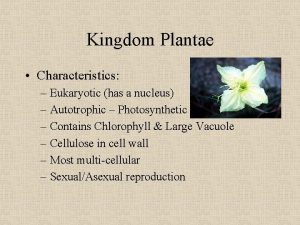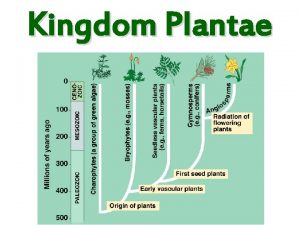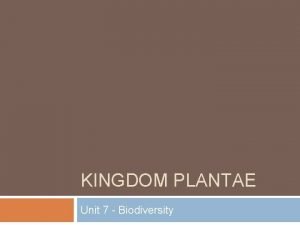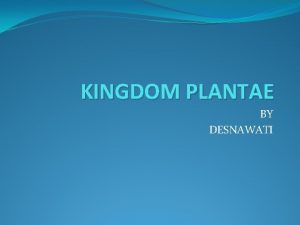Kingdom Plantae Characteristics of plants All Plants Eukaryotic












































- Slides: 44

Kingdom Plantae

Characteristics of plants All Plants: Eukaryotic Multicellular Autotrophic Used for Classification: Pigments: chlorophyll, carotenoids, fucoxanthins, xanthophylls Energy Storage: starches Tissues: vascular/non for transporting H 2 O & nutrients Structures: roots, stems, leaves Life Cycles/Alternation of Generations: gametophytes = n, sporophytes = 2 n Reproduction: presence/absence of seed presence/absence of fruit

Characteristics of plants • Multicellular eukaryotic photosynthetic autotrophs • Mainly terrestrial and sessile • Display an alternation of generations. – sporophyte and gametophyte are heteromorphic-the two generations look and develop differently from each other. – In algae the gametophyte is dominant, in most plants the sporophyte is dominant. • Sugars made via photosynthesis are used as a fuel source for growth and also stored as the complex carbohydrate starch. • Cell walls are made of cellulose. • The Source of the Oxygen Produced by Photosynthesis • Photophosphorylation • Tracing the Pathway of CO 2

Alternation of Generations

PLANT LEAF performs photosynthesis CUTICLE reduces water loss; STOMATA allow gas exchange STEM supports plant (and may perform photosynthesis) Surrounding water supports the alga ROOTS anchor plant; absorb water and minerals from the soil (aided by mycorrhizal fungi) ALGA WHOLE ALGA performs photosynthesis; absorbs water, CO 2, and minerals from the water HOLDFAST anchors the alga Figure 17. 1 A

• Unlike algae, plants have vascular tissue – It transports water and nutrients throughout the plant body – It provides internal support Figure 17. 1 B

Plant Evolution • First plants appeared about 475 mya. • By 375 mya, plants were abundant & diverse. • 250, 000+ species of extant plants • Plants evolved from green algae (closest relatives are the Charophytes).

Figure 29. 4 Charophytes, closest algal relatives of the plant kingdom Plants evolved from green algae called charophyceans (Green Algae)

Figure 29. 10 Cooksonia, a vascular plant of the Silurian 408 mya

Making the move to dry land Required several evolutionary breakthroughs. What would be the key adaptations needed if you are going from an aquatic to a terrestrial existence? Cooksonia Charophyte Modern angiosperm

Terrestrial challenges • Air offers no support to fight gravity. • Water is less available which results in dessication, immotility of sperm, lack of absorption, problems with gas exchange and a need for conduction • Nutrients and water are in soil, but CO 2 and light are above ground.

Adaptations needed for terrestrial life: • Protective covering to prevent dehydration • Transport system for water & nutrients • Structural system for support (woody tissue) • Discrete organs- roots, stems, leaves & gametangia. • Mechanism to allow sperm to get to egg • Protective covering for gametes & embryos

17. 3 Plant diversity provides clues to the evolutionary history of the plant kingdom • Two main lineages arose early from ancestral plants

• One lineage gave rise to bryophytes – These are plants that lack vascular tissue – Bryophytes include mosses, which grow in a low, spongy mat Figure 17. 3 B

Four Major Plant Groups: 1. Nonvascular Plants 2. Vascular Plants without Seeds 3. Vascular Plants with Naked Seeds 4. Vascular Plants with Seeds, Flowers, and Fruits

Evolutionary tree of the major plant groups

Avascular Plants : Mosses, Hornworts & Liverworts

Life Cycle of a Moss

• Vascular plants are the other ancient lineage • Ferns and seed plants were derived from early vascular plants and contain – xylem and phloem – well-developed roots – rigid stems

• Ferns are seedless plants whose flagellated sperm require moisture to reach the egg

Seedless Vascular Plants : Ferns, Club mosses, Horsetails and Whisk ferns

New evolutionary adaptations: • Waxy cuticle • Gametangia Features still absent in this group: • No well developed vascular system • No support system • Require water for sperm to swim to egg

Fig. 35. 20 Cuticle: waxy covering on the surface of plant stems and leaves which prevents desiccation; Stoma (stomata): microscopic pore surrounded by guard cells in the epidermis of stems and leaves that allows gas exchange

New Evolutionary Adaptations in addition to waxy cuticle and gametangia: • Vascular tissue/Support tissue -tracheids Adaptations still lacking: • Mechanism for the sperm to reach egg without a film of water

Figure 29. 0 Ferns

Figure 29. 11 The life cycle of a fern Fern Life Cycle 1, 2

Figure 29. 11 xa Life cycle of a fern: mature fern (diploid sporophyte)

Figure 29. 11 xf Life cycle of a fern: gametophyte

Figure 29. 11 h Life cycle of a fern: sporophytes

Seedless plants formed vast “coal forests” • Ferns and other seedless plants once dominated ancient forests – Their remains formed coal Figure 17. 7

• Gymnosperms that produce cones, the conifers, largely replaced the ancient forests of seedless plants – These plants remain the dominant gymnosperms today

A pine tree is a sporophyte with tiny gametophytes in its cones • Sporangia in male cones make spores that develop into male gametophytes – These are the pollen grains • Sporangia in female cones produce female gametophytes

4 Female gametophyte (n) Haploid spore cells in ovule develop into female gametophyte, which makes egg. 5 Male gametophyte (pollen) Egg (n) grows tube to egg and makes and releases sperm. Sperm (n) HAPLOID DIPLOID MEIOSIS Ovule Male gametophyte (pollen grain) Fertilization Scale Sporangium (2 n) Seed coat 3 Pollination HAPLOID Pollen grains (male gametophytes) (n) Embryo (2 n) Integument 1 Female cone bears ovules. 6 Zygote develops MEIOSIS into embryo, and ovule becomes seed. 2 Male cone produces spores by meiosis; spores develop into pollen grains Zygote (2 n) 7 Sporophyte Seed falls to ground and germinates, and embryo grows into tree. Life Cycle of a Conifer

The flower is the centerpiece of angiosperm reproduction • Most plants are angiosperms – The hallmarks of these plants are flowers Pollen grains Anther Stigma CARPEL Ovary STAMEN PETAL Ovule SEPAL Figure 17. 9 A, B

The angiosperm plant is a sporophyte with gametophytes in its flowers • The angiosperm life cycle is similar to that of conifers – But it is much more rapid – In addition, angiosperm seeds are protected and dispersed in fruits, which develop from ovaries

2 Haploid spore in each Stigma Egg (n) ovule develops into female gametophyte, which produces egg. 3 Pollination Pollen grain and growth of pollen tube Ovule Pollen tube 1 Haploid spores in anthers develop into pollen grains: male gametophytes. Sperm Pollen (n) Meiosis HAPLOID Fertilization DIPLOID 4 7 Seed Ovary Seeds germinates, and embryo grows into plant. Ovule Sporophyte Zygote (2 n) Seed coat Food supply 5 Seed Embryo (2 n) 6 Fruit Double Fertilization

The structure of a fruit reflects its function in seed dispersal • Fruits are adaptations that disperse seeds

Types of Fruits • Simple Fruits: These fruit types are produced by flowers containing one pistil, the main female reproductive organ of a flower. • Aggregate Fruits: These fruits types are developed from flowers which have more than one pistils. They consist of mass of small drupes that develops from a separate ovary of a single flower. • Multiple Fruits: These fruit types are developed not from one single flower but by a cluster of flowers. • Accessory Fruits: These fruit types are developed from plant parts other than the

Types of fleshy fruits Pepo: berry True berry: has an have a soft outer wall epicarp and /rind that is the formed mesocarp from and receptacle endocarp is tissue that fleshly is fused to exocarp. Hesperidium: Multiple fruit: Aggregate fruit: have thick, individual formed from the leathery ovaries from development of exocarp and different a number of mesocarp. flowers get simple carpels They have a clustered from a single juicy, pulpy together flower. endocarp forming a fruit. Tomato, Eggplant, Chili pep, Grape, Cranberry, Orange, Lemon, Lime, Grapefruit Pumpkin, Gourd, Cucumber, Melon Blackberry, Raspberry, Boysenberry Accessory fruit Pineapple, Fig, Mulberry, Strawberry Hedge apple There are fruits that are dry fruits and can be differentiated as dry dehiscent and dry indehiscent. Fruit types that contain seeds in a seedpod that opens up and releases the seeds are known as dehiscent fruits. Legume: Sweet pea, Beans, Peanut The indehiscent are those fruit types that do not have a seed pot that opens. Caryopsis: Wheat, Rice , Corn, Rye Nuts: The list of fruits under this type are: Walnut, Acorn

Agriculture is based almost entirely on angiosperms • Gymnosperms supply most of our lumber and paper • Angiosperms provide most of our food – Fruits, vegetables, and grains • Angiosperms also provide other important products – Medications, fiber, perfumes

Interactions with animals have profoundly influenced angiosperm evolution • Angiosperms are a major source of food for animals – Animals also aid plants in pollination and seed dispersal Figure 17. 13 A-C

Connection: Plant diversity is a nonrenewable resource • 20% of the tropical forests worldwide were destroyed in the last third of the 20 th century • The forests of North America have shrunk by almost 40% in the last 200 years Figure 17. 14

• Some plants in these forests can be used in medicinal ways – More than 25% of prescription drugs are extracted from plants

Resources • http: //generalhorticulture. tamu. edu/HORT 604/ Lecture. Suppl/Anatomy. Organs/Anatomy. Organ s 05. htm • The Conquest of Land • Plant Evolution Tour • Identification of Major Fruits
 Protista prokaryotic
Protista prokaryotic Protista mobility
Protista mobility Share
Share Domain: eukarya kingdom: protista
Domain: eukarya kingdom: protista Characteristics of kingdom plantae
Characteristics of kingdom plantae Plant kingdom
Plant kingdom Characteristics of kingdom plantae
Characteristics of kingdom plantae Plantae kingdom characteristics chart
Plantae kingdom characteristics chart Plantae special characteristics
Plantae special characteristics Common characteristics of plantae
Common characteristics of plantae Old kingdom middle kingdom new kingdom
Old kingdom middle kingdom new kingdom Old kingdom middle kingdom new kingdom
Old kingdom middle kingdom new kingdom Youtube
Youtube Capital of egypt during the old kingdom
Capital of egypt during the old kingdom Kingdom plante
Kingdom plante Categories of protists
Categories of protists What is the most diverse kingdom
What is the most diverse kingdom Animal taxonomy tree
Animal taxonomy tree Lycodiophyta
Lycodiophyta What domain is plantae in
What domain is plantae in Animalia fungi plantae
Animalia fungi plantae Beneficial algae
Beneficial algae Animalia cladogram
Animalia cladogram Tracheobionta
Tracheobionta Pyrrophyta
Pyrrophyta Plantae multicellular
Plantae multicellular Kingdom plantae chart
Kingdom plantae chart Perbedaan anteridium dan arkegonium
Perbedaan anteridium dan arkegonium Parts of flower
Parts of flower Guard cells
Guard cells Kingdom of ferns
Kingdom of ferns Eukarya plantae
Eukarya plantae Kingdom protista chart
Kingdom protista chart Multicellular algae kingdom
Multicellular algae kingdom Plantae mobility
Plantae mobility Are plants eukaryotic
Are plants eukaryotic Are plants eukaryotic
Are plants eukaryotic Name all rays
Name all rays Gnetae
Gnetae Odds and ends kingdom
Odds and ends kingdom Protista
Protista The protist kingdom
The protist kingdom Fungi examples
Fungi examples Vascular plants
Vascular plants Non vascular plant reproduction
Non vascular plant reproduction




